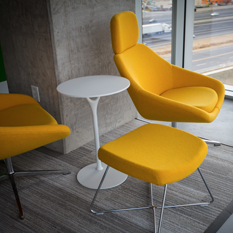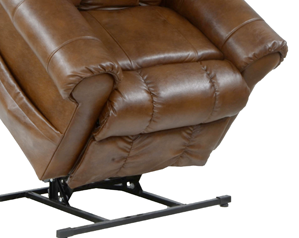Creating a Collaborative Workspace: The Power of Office Sofas
Gone are the days of sterile, isolated cubicles. Today's work environment thrives on collaboration, where teams come together to brainstorm, solve problems, and drive innovation. This shift demands a workspace that fosters interaction and a sense of community. Enter the humble office sofa – a surprisingly powerful tool for creating a collaborative environment.

Why Collaboration Matters
Success hinges on effective teamwork. Collaborative workspaces demonstrably enhance several key aspects of an organisation:
- Creativity and Innovation: When diverse perspectives come together in an open environment, the exchange of ideas flourishes. Office sofas, with their inviting nature, encourage casual brainstorming sessions that can spark unexpected solutions.
- Problem-Solving: Complex challenges often require collective thinking. Collaborative spaces facilitate open communication and allow teams to tackle problems from multiple angles, leading to more effective solutions.
- Employee Engagement: Feeling isolated and unheard can quickly demotivate employees. Collaborative workspaces foster a sense of belonging and encourage employees to actively participate, boosting morale and engagement.
- Productivity: Streamlined communication and teamwork lead to faster project completion. Collaborative spaces create opportunities for impromptu discussions that can resolve issues quickly and keep projects moving forward.
The Magic of Office Sofas
While conference rooms have traditionally served as collaboration hubs, office sofas offer a more relaxed and dynamic alternative. Here's how they contribute to a collaborative workspace:
- Breaking Down Barriers: Unlike traditional desks and cubicles, office sofas create a less formal setting. This encourages casual interactions and impromptu brainstorming sessions, fostering a more open exchange of ideas.
- Creating Conversation Corners: Strategically placed sofas establish designated areas for informal discussions. Teams can gather for quick check-ins, project updates, or spontaneous brainstorming sessions, fostering a sense of community and teamwork.
- Flexibility and Adaptability: Office sofas, unlike bulky conference tables, offer greater flexibility. They can be easily rearranged to accommodate different group sizes and activities, making the space adaptable to diverse collaborative needs.
- A Change of Scenery: Sitting in the same chair all day can lead to fatigue and decreased focus. Sofas provide a comfortable alternative for employees seeking a change of posture or scenery. This can be particularly beneficial for brainstorming sessions, where a relaxed atmosphere can spark creative thinking.
Choosing the Right Office Sofa
Not all office sofas are created equal. Here are some key factors to consider when selecting the perfect sofa for your collaborative workspace:
- Size and Scale: Choose sofas that fit proportionately within the designated space. Oversized sofas can overpower a room, while small ones might not offer enough seating. Consider the typical team size for collaborative sessions and choose accordingly.
- Style and Comfort: The sofa's style should complement your overall office aesthetic. However, prioritise comfort. Opt for ergonomic designs with supportive cushions and ample backrests to ensure prolonged comfort during brainstorming sessions.
- Durability and Functionality: Collaborative spaces see a lot of use. Invest in well-made sofas with durable upholstery that can withstand frequent use and clean easily. Consider features like built-in tables or ottomans to enhance functionality and create a more versatile workspace.
Designing a Collaborative Oasis
Office sofas are just one piece of the collaborative workspace puzzle. Here are some additional tips to create an inspiring environment:
- Open Layout: Consider an open floor plan that eliminates physical barriers and encourages interaction.
- Variety of Seating: Offer a mix of seating options beyond sofas, including high-top tables for stand-up meetings and comfortable chairs for focused work.
- Technology Integration: Equip collaborative areas with whiteboards, projectors, and screens to facilitate effective idea-sharing and presentations.
- Natural Light and Greenery: Natural light and plants not only brighten the space but also contribute to employee well-being and creativity.
- Acoustic Solutions: Open spaces can be noisy. Consider wall panels, sound-absorbing furniture, and designated quiet areas to balance collaboration with focused work.
Beyond the Sofa: The Importance of Ergonomic Office Chairs

While sofas offer a comfortable space for collaboration, ergonomic office chairs remain crucial for individual work. Here's how our selection of office chairs complements your collaborative space:
- Maintaining Good Posture: Ergonomic chairs promote proper posture and reduce back pain, neck strain, and other musculoskeletal issues. This is vital for employees who spend long hours at their desks, ensuring they stay comfortable and focused throughout the workday.
- Increased Productivity: Good posture improves blood circulation and oxygen flow to the brain, leading to increased alertness and focus. Ergonomic chairs contribute to a more productive work environment.
- Reduced Sick Leave: Musculoskeletal issues caused by poor posture are a leading cause of employee absenteeism. Ergonomic chairs can help prevent these issues, keeping your team healthy and productive.
Conclusion
Office sofas are a powerful tool for creating a collaborative workspace that promotes teamwork, creativity, and employee well-being. By strategically incorporating sofas into your office design, you can break down barriers, promote flexibility, and enhance the overall work experience for your team members. Whether it's facilitating impromptu meetings, providing a comfortable space for relaxation, or adding a touch of style to the office environment, office sofas have the power to transform your workspace and elevate the way your team works together.
- 26.04.2024
-
Category:
- Contemporary Furniture Blog